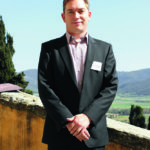ShipConstructor CEO Darren Larkins expects an increasing use of virtual reality, but it remains a cost consideration. In terms of markets, Brazil has the most growth potential
Mr Larkins, in your COMPIT paper you were discussing the democratization of virtual reality (VR) in shipbuilding. What stands[ds_preview] behind the increasing use of VR?
Darren Larkins: The amount of information that is generated during the design, engineering and construction of a ship is growing at a pace that the human mind can’t keep up with. Therefore, tools like VR are now fundamentally required to visualize that information. Also, if you are able to visualize something in an understandable way this allows you to capture so many errors before the steel cutting and actual construction phase starts. Thus, you save a lot of money on the most expensive part of the ship: the material.
What kind of feedback do you get from shipyards regarding this innovation?
Larkins: It has changed a lot. Ten years ago you couldn’t start a conversation about VR. At that time managers wouldn’t accept that engineers needed to use tools that they saw as video games. Today 3D is everywhere and video gaming has become a mass phenomenon, so most people are pretty open to the idea of virtual reality. But it remains a cost consideration. Our customers in the ship design and shipbuilding industry really need to understand why this is going to save them money. There is still the idea out there that visualization and virtual reality tools are very expensive and hard to implement. This is what we at ShipConstructor want to change.
And probably you have many good arguments at hand…
Larkins: Absolutely. Shipbuilding nowadays is so complex that you cannot allow yourself any mistakes to get to the next step in the process. In some ways this is similar to software development. We have a – what we call – »1-2-5-10 rule« which means to not make an error costs you nothing, to fix it after the product has actually been developed costs you twice as much, to fix the error during quality assessment costs you five times, and to fix it when the product has gotten into the hands of the user costs you ten times what it would have cost when you captured it in the first place. Similar rules apply to shipbuilding. Therefore, it is important to stop this cascading effect as early as possible.
Besides virtual reality, what are other important fields of interest and research for ShipConstructor at the moment?
Larkins: We are focusing on helping our clients solve more and more of the challenges they face, even if those are only peripheral to engineering. To do so we have looked at other technologies like reality capture, specifically laser scanning and photogrammetry which involve the creation of CAD models from high resolution laser scans and digital photography respectively. Another important topic is enterprise integration across the client’s organization. We are developing a platform that integrates everything like PLM or ERP systems into the engineering model.
In which market segments do you expect to grow most strongly?
Larkins: We try to be as segment-neutral as possible, however the largest increase can be expected in the offshore oil market. Brazil is the market where we see the most potential. We have already had a lot of success there because the local shipyards had a lack of educated engineering labour after the decline of the shipbuilding industry from the 1980s to 2000. We believe ShipConstructor is the easiest software to implement and train which was critical to build the required workforce. In the last five years, at least 20 jack-up rigs have been constructed with our software. Talking about offshore, also wind energy is interesting for us. For example, the wind farm installation vessels for Seajacks from Lamprell shipyard in the UAE have been built with ShipConstructor software.
Next to emerging markets, Asia and North America are most important for us. Europe is still tough, but we are optimistic to grow there since we see quite a number of innovative shipyards as potential customers.
Nikos Späth




















